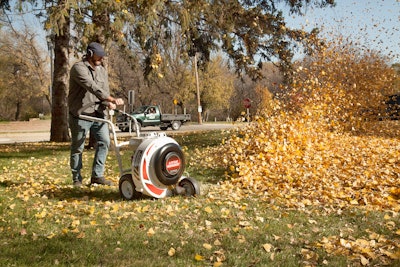
It’s said that two heads are better than one, and it’s likely because the issues or problems at hand almost always benefit from dual perspectives. When it comes to fall cleanup, the same rings true. While a backpack leaf blower shows its strengths in the confines of small flowerbeds, there are ergonomic, productivity and profit benefits to be gained when pairing it with a walk-behind unit.
The One-Two Punch
It’s not often there’s a lawn without a house, trees, or some sort of structure or feature to work around, and likewise, it’s not often there are structures and features to work around, and no lawn. They almost always go hand in hand, which is why using backpack and walk-behind units in tandem is the best way to maximize productivity on leaf-blowing projects. Landscapers can use backpack blowers to navigate around buildings and features, such as shrubs and flowerbeds, quickly moving leaves to the lawn, then use a walk-behind unit to power through the bulk of the work. Here’s why this one-two punch works so well ...
Something in the Air
Walk-behind leaf blowers deliver 150 to 200 MPH of air speed, which is similar to some backpack models. What really sets a push model apart is the rate at which the air travels or cubic feet per minute (CFM). Backpack blowers range from 370 to 912 CFM, while walk-behind units deliver an impressive 1,100 to 2,850 CFM, as much as 87 percent more than backpack models. This is why walk-behind leaf blowers are ideal for quickly clearing large areas.
One would think the greater the air speed and CFM, the farther operators can move debris in a single pass. That may be true to some extent, but there is more at play: What really sets a blower apart in terms of performance is design.
For example, a split-stream system, as opposed to a single-stream system, splits the air stream in two, so the majority of the air pushes the debris, while the lighter air stream prevents blowback to effectively move debris in one pass.
Most push units have a single-stream system, which results in a weaker airflow that limits how far the unit can push debris. They also cannot effectively break up and dislodge wet leaves, whether around structures and shrubs, or stuck to the ground. Even backpack blowers struggle with wet leaves. The task often requires operators to hold leaf blowers at different angles in an attempt to break apart the leaves or simply remove them by hand, causing jobs to take even longer.
A walk-behind blower with a split-air-stream system, however, maximizes air speed to effectively move stuck and waterlogged leaves. Operators can still maintain full control of the air stream thanks to levers on the operator’s handles that allow for on-the-go adjustments.
Digging a little into equipment design, impellers and components also have an impact on blower performance. When comparing walk-behind units, reverse angled blades rather than straight radial fan blades enhance impeller efficiency. That, paired with an aerodynamic air inlet, can deliver as much as 38 percent more air movement than other units. This is possible because those features allow the blowers to maintain constant air power and don’t clog if leaves are drawn in.
Do the Math
It’s clear that not all walk-behind blowers are the same and they outperform backpack models every time. But for contractors still on the fence about using both in tandem, the math can be quite convincing.
For example, a half-acre lawn could take several hours to clear using a backpack leaf blower, but a walk-behind unit with a split-stream system, and optimized impeller and component design cuts that time down with less manpower. For landscapers, that time equates to more jobs billed at the same rate, completed in less time. That results in significant revenue.
Getting a job done faster is definitely appealing, but that may not mean going for the largest horsepower walk-behind unit. Although more power is typically ideal, it’s not always the best option. A smaller horsepower push blower might work better on smaller jobs to avoid blowing leaves farther than desired, such as into the next lawn. They also give contractors plenty of power to work efficiently on day-to-day projects and the control to direct leaves exactly where they belong. In addition, walk-behind units provide a faster option than backpack models to keep productivity up on large projects.
Smaller walk-behind leaf blowers are great entry-level models and provide a feel for their enhanced productivity. Contractors can always jump up to a higher capacity model as business grows and they take on more jobs. Keep in mind, regardless of the size of the walk-behind blower, a split-air stream and optimal impeller and components are still important features to consider because they maximize efficiency.
The Price of Ergonomics
The benefits of the walk-behind and backpack blower one-two punch add up in more ways than productivity and profits—the price of ergonomics must also be factored in. Using equipment that isn’t ergonomic always runs the risk of workers’ compensation claims, which can cost a company five figures. It also can create issues with employee retention as workers typically prefer working with more comfortable equipment.
According to a 2010 study by the National Center for Biotechnology Information, the constant weight of a 26-pound backpack can compress spinal cords, and lead to chronic back and shoulder pain. Some operators even report arm and hand numbness.
Conversely, walk-behind leaf blowers are easy to use and offer better ergonomics. Many models are self-propelled in both the forward and reverse directions so they require little force to move, whether on level ground, or navigating over hills and uneven turf. Operators can adjust handles to the proper height and work comfortably thanks to vibration-reduction handles, which minimize how much vibrations are transferred to the operator. Even all the necessary controls are within reach.
Because walk-behind blowers work faster than backpack models, operators use them for shorter periods of time, which equates to less strain on the body and minimal risk of injuries.
While walk-behind leaf blowers benefit contractors all over the landscape, there is still a time and place for backpack blowers.
Jobsites often feature tight spaces, such as clusters of trees or bushes up against houses. A backpack leaf blower gives operators the flexibility to weave in and out of these tight spaces with ease, clearing small areas of dry leaves and lightweight debris. But take a step out into the wide expanse of a lawn, and productivity begins to suffer. Backpack blowers simply do not have enough power to move leaves quickly in this application, not to mention that carrying around a 25-pound unit for several hours can get uncomfortable and cause back issues.
While using a backpack blower for larger projects can be done, it comes at a huge cost in time and ergonomics unless contractors have the backup power of walk-behind units.
Trailer space can be a big issue for many contractors, too, which is why some exclusively use backpack blowers. They can be hung up and out of the way. However, the extra square feet in space they are saving is likely not worth the productivity and ergonomic gains contractors could be missing out on; a walk-behind leaf blower takes up minimal space and is worth its footprint in return on investment.
Just like two people can solve a problem that an individual can’t, pairing tools that can tackle different aspects of a job can be the one-two punch projects need. When productivity and profits are on the line—and they’re on the line every day—tools like these can make or break a business. ›

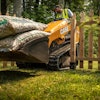
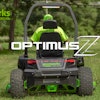
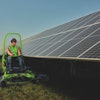
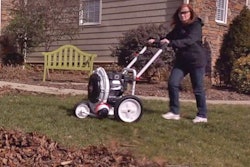
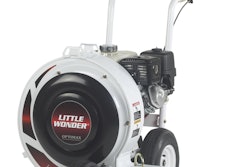
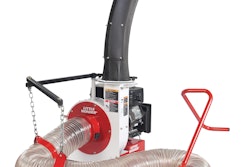








![Gravely Pro Turn Mach One My23 Dsc03139 Edit 1200x800 5b2df79[1]](https://img.greenindustrypros.com/mindful/acbm/workspaces/default/uploads/2025/10/gravely-pro-turn-mach-one-my23-dsc03139-edit-1200x800-5b2df791.BucBnDoN22.jpg?ar=16%3A9&auto=format%2Ccompress&fit=crop&h=135&q=70&w=240)




